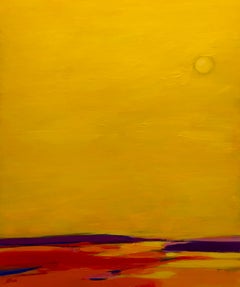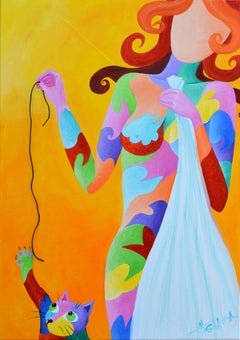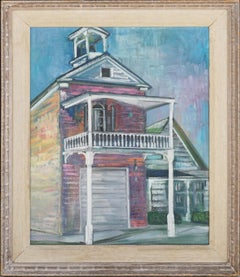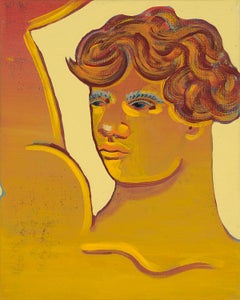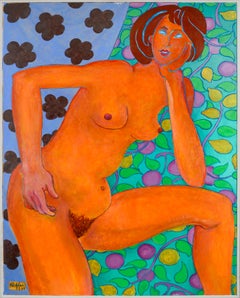Fauvist Art
Style: Fauvist
Color: Orange
Into the Light
Located in Fairfield, CT
Represented by George Billis Gallery.
Armine Bozhko works on the crossroads of different cultures- she was born in Ukrainian-Armenian family of writers and diplomats, studied in Rep...
Category
2010s Fauvist Art
Materials
Canvas, Oil
Early Morning
Located in Fairfield, CT
Represented by George Billis Gallery.
Armine Bozhko works on the crossroads of different cultures- she was born in Ukrainian-Armenian family of writers and diplomats, studied in Rep...
Category
2010s Fauvist Art
Materials
Canvas, Oil
Golden Light
Located in Fairfield, CT
Represented by George Billis Gallery.
Armine Bozhko works on the crossroads of different cultures- she was born in Ukrainian-Armenian family of writers and diplomats, studied in Rep...
Category
2010s Fauvist Art
Materials
Canvas, Oil
In Silence
Located in Fairfield, CT
Represented by George Billis Gallery.
Armine Bozhko works on the crossroads of different cultures- she was born in Ukrainian-Armenian family of writers and diplomats, studied in Re...
Category
2010s Fauvist Art
Materials
Canvas, Acrylic
French Contemporary Art by Galka - La Ficelle
Located in Paris, IDF
Oil on linen
Galina Navodnitchaia-Malfoy alias Galka is a French artist born in 1971 who lives and works in Callians near Cannes in France. At the School of Fine Arts in Brest, Bel...
Category
2010s Fauvist Art
Materials
Oil, Linen
French Contemporary Art by Galka - Gaia
Located in Paris, IDF
Oil on canvas
Galina Navodnitchaia-Malfoy alias Galka is a French artist born in 1971 who lives and works in Callians near Cannes in France. At the School of Fine Arts in Brest, Bel...
Category
2010s Fauvist Art
Materials
Oil, Canvas
Fauvist Abstract Expressionist Lowland Gorilla
Located in Soquel, CA
Wonderful fauvist painting of an abstract expressionist Lowland Gorilla with high voltage hues by Daniel Nester (American, b1959), 2017. Signed lower right corner and on verso. Date,...
Category
2010s Fauvist Art
Materials
Oil, Canvas
Early 20th Century drawing of a nude by French Fauvist artist Andre Derain
By André Derain
Located in Petworth, West Sussex
Andre Derain (French, 1880 – 1954)
A nude looking up
Pencil on paper
Signed with atelier stamp (lower right)
16.1/2 x 9.1/8 in. (41.1 x 23.1 cm.)
André Derain (10 June 1880 – 8 Sept...
Category
Early 20th Century Fauvist Art
Materials
Pencil, Paper
Fauvist Abstract Expressionist Tiger
Located in Soquel, CA
Wonderful fauvist painting of an abstract expressionist Tiger with high voltage hues by Daniel Nester (American, b1959), 2017. Signed lower right corner and on verso. Date, title and...
Category
2010s Fauvist Art
Materials
Oil, Canvas
Portrait of a Fauvist Nude Figurative
By Don Klopfer
Located in Soquel, CA
Brightly colored nude by California artist Don Klopfer (1920-2009). Signed and dated "Klopfer 93" upper left corner. Presented in a white slat frame. Canva...
Category
1990s Fauvist Art
Materials
Linen, Oil
The Blue Cabin - Vertical Landscape
By Karen Druker
Located in Soquel, CA
Brightly colored landscape of a cabin in the woods by Karen Druker (American, 1945). Signed "Druker" in the lower right corner. Presented in a cream mat. No frame. Image size: 30"H x...
Category
21st Century and Contemporary Fauvist Art
Materials
Paper, Pastel, Watercolor
Buste de guerrier Masai - Huile sur panneau, 102x68cm, encadré
Located in Nice, FR
Portrait of a Masai, oil on panel. With frame: 124cm x 91cm.
Patrice Landauer est un artiste peintre français né en 1965.
Patrice Landauer a approfo...
Category
Late 20th Century Fauvist Art
Materials
Wood Panel, Oil
Woman with Orange Cat
Located in Santa Monica, CA
Acrylic on canvas.
Category
2010s Fauvist Art
Materials
Canvas, Acrylic
Fauvist Figure with Flowers
Located in Soquel, CA
Bright, colorful Fauvist figurative painting of a woman with vase of flowers in a vibrant interior space, by an unknown Bay Area artist (American, 20th...
Category
1980s Fauvist Art
Materials
Canvas, Oil
Still Life - Lithograph
Located in Collonge Bellerive, Geneve, CH
(after) Raoul Dufy
Lithograph after a watercolor, published in the book "Lettre à mon peintre Raoul Dufy." Paris, Librairie Académique Perrin, 1965.
Printed signature
Di...
Category
1940s Fauvist Art
Materials
Lithograph
Passage
Located in Miami, FL
Passage is a colorful painting made by Evelyne Ballestra, a French contemporary artist. This orange tons expressionist painting is inspired from an enchanted wood, showing the nature...
Category
1990s Fauvist Art
Materials
Oil, Canvas
Carroussel
Located in Miami, FL
Carroussel is a painting made by Evelyne Ballestra, a French contemporary artist. This piece is a part of a flower series, defined by their distinct bright colors, satiny, silky, vib...
Category
21st Century and Contemporary Fauvist Art
Materials
Canvas, Oil
Related Items
Flowers street Barcelona Spain spanish urbanscape oil on canvas painting
Located in Barcelona, Barcelona
José Luis Florit Rodero (1909-2000) - Barcelona - Oil on canvas
Oil measures 65x81 cm.
Frameless.
José Luis Florit Rodero (Madrid, 1909-Paris,...
Category
1980s Fauvist Art
Materials
Oil, Canvas
Mid Century Fauvist Gold Country Home Landscape
Located in Soquel, CA
Mid Century fauvist style landscape of California Gold Country home by an unknown artist (American, 20th Century) c.1960. Unsigned. Presented in ru...
Category
1950s Fauvist Art
Materials
Canvas, Cardboard, Oil
Abstract landscape painting in yellow and gold tones, "Learning with the forest"
Located in THOMERY, FR
Linda Clerget's abstract cosmic plant paintings are a journey through the universe and nature. With vibrant colors and clean shapes, these paintings tran...
Category
21st Century and Contemporary Fauvist Art
Materials
Acrylic
H 17.72 in W 24.02 in D 0.4 in
Antique Fauvist "Still Life with Flowers and Skull" Louis Mathieu Verdilhan
Located in SANTA FE, NM
Antique Fauvist Vanitas "Still Life with Flowers and Skull"
Louis Mathieu Verdilhan (Provence, France, 1875-1928)
Circa 1910
Oil on canvas on ...
Category
Early 1900s Fauvist Art
Materials
Canvas, Wood, Oil
Cadaques Spain oil on canvas painting fauvism spanish seascape urbanscape
By Jordi Curos
Located in Barcelona, Barcelona
Jordi Curós Ventura (1930-2007) - Cadaques - Oil on canvas.
Work measurements 61x50 cm.
Frame size 66x55 cm.
Jordi Curós Ventura (Olot, Girona, March 4, 1930) is a Spanish painter.
...
Category
1980s Fauvist Art
Materials
Oil, Canvas
"this is not a place" (III) - Vertical Fauvist Landscape in Acrylic on Canvas
Located in Soquel, CA
Abstracted landscape by California artist Devon Brockopp-Hammer (American, b. 1986). The bold orange underpaint has been allowed to shine through the co...
Category
2010s Fauvist Art
Materials
Charcoal, Canvas, Acrylic
Fauvist Big Sur Coast Landscape
Located in Soquel, CA
Vibrant oil on canvas abstracted coastline landscape by California artist Virginia Sevier Rogers (American, 1917-2015), 1995. Signed, dated, and titled "Coast V.R. 5/95" upper right....
Category
1990s Fauvist Art
Materials
Oil, Canvas
Plaza nueva Barcelona Spain oil on canvas painting urbanscape
By Ignasi Mundó
Located in Barcelona, Barcelona
Ignasi Mundó Marcet (1918-2012) - Plaza Nueva Barcelona Spain - Oil on canvas
Canvas measures 73x60 cm.
Frameless.
MUNDO Ignasi
Ignasi Mundó trained at t...
Category
1980s Fauvist Art
Materials
Oil, Canvas
H 28.75 in W 23.63 in
Barcelona Spain spanish urbanscape acrylic painting
Located in Barcelona, Barcelona
Jose Luis Florit - View of Barcelona - Acrylic paper glued to canvas
Canvas measurements 73x92 cm.
Frameless.
José Luis Florit Rodero (Madrid,...
Category
1980s Fauvist Art
Materials
Acrylic, Paper, Canvas
H 28.75 in W 36.23 in
Ocean Sunset Landscape
By Don Klopfer
Located in Soquel, CA
Boldly colored sunset seascape by California artist Richard "Don" Klopfer (1920-2009). Signed and dated in the lower left corner ("Klopfer 12-98"). Canvas laid down on Masonite. No frame. Board size: 7.5"H x 9.5"W
Richard "Don" Klopfer (1920-2009) attended the National Art School in Washington D.C. and the California College of Arts and Crafts in Oakland, California. Klopfer was a life-long, passionate visual artist who worked in a variety of mediums, including oil paints, wood and bronze. His gallery "The Flair" was on Pico Blvd West Los Angeles from 1954 to 1980 was a gathering place for artists, friends and collectors.
He was recognized for the use of brilliant color in his paintings and for leaving drawings everywhere he went. Klopfer's painting "My Old House" is on permanent exhibition at San Luis Obispo Museum of Art (SLOMA). He has also exhibited at The Los Angeles County Art Museum, Esther Robles Gallery, Third Street Gallery, Westwood Art Association, Barnsdale Park, and Robert Pyle Gallery.
Selected Exhibitions:
1990 - Wild Horse Gallery - San Luis Obispo, CA
1991 - “South County Journey” - El Camino Arti Association Gallery - Pismo Beach...
Category
Late 20th Century Fauvist Art
Materials
Acrylic, Canvas, Masonite
Fauvist Portrait of Woman
By Sarena Rosenfeld
Located in Soquel, CA
Vibrant fauvist portrait of a woman by Sarena Rosenfeld (American, b. 1940), 1995. Signed and dated lower right hand corner and on verso. Titled "Smoke and Mirrors." Gallery wrapped ...
Category
1990s Fauvist Art
Materials
Canvas, Oil
Aperitif on the terrace of the bar spanish oil on canvas painting
Located in Barcelona, Barcelona
Illegible signature lower right.
Oil measures 38x46 cm.
Frameless.
Dated 1976.
Category
1970s Fauvist Art
Materials
Oil, Canvas
Previously Available Items
'Helios' - figurative - fauvist - colorful - portrait
Located in Atlanta, GA
This colorful figurative work features hues of yellow, orange and blue.
Shelby Little is an artist from New Orleans living in Athens, Georgia. She paints as an exploration of her sp...
Category
2010s Fauvist Art
Materials
Canvas, Acrylic
Portrait of a Woman with Flowers & Leaves - Fauvist Nude Botanical Figurative
By Don Klopfer
Located in Soquel, CA
Bold Fauvist colors and a fun patterned background with flower and plant motifs characterize this unique and colorful depiction of a nude female in orange by California artist Don Klopfer...
Category
1990s Fauvist Art
Materials
Linen, Oil
H 40.75 in W 30.75 in D 1 in
Elmyr De Hory Colorful Fauvist Lithograph after Henri Matisse Hand Signed
By Elmyr de Hory
Located in Surfside, FL
Elmyr de Hory (born Elemér Albert Hoffmann; Budapest, 1906 – Ibiza, 1976) was a Hungarian-born painter and art forger, who is said to have sold over a thousand art forgeries to reputable art galleries all over the world. His forgeries garnered celebrity from a Clifford Irving book, Fake (1969); a documentary essay film by Orson Welles, F for Fake (1974); and a biography by Mark Forgy, The Forger's Apprentice: Life with the World's Most Notorious Artist (2012).
De Hory claimed that he was born into an aristocratic family, that his father was an Austro-Hungarian ambassador and that his mother came from a family of bankers. However, subsequent investigation has suggested that de Hory's childhood was, more likely, of a middle-class variety; he was born Elemér Albert Hoffmann on April 14, 1906. (An acquaintance, Fernand Legros, said that de Hory was born in Budapest (Hungary) 14 April 1905, but that de Hory would change the date to 1914 to appear younger. Both his parents were Jewish. His father's occupation was listed as "wholesaler of handcrafted goods." His parents did not divorce when he was sixteen, as he had asserted in the Clifford Irving biography. At the age of 16, he began his formal art training in the Hungarian art colony of Nagybánya (now in Romania). At 18, he joined the Akademie Heinmann art school in Munich, Germany, to study classical painting. In 1926 he moved to Paris and enrolled in the Académie la Grande Chaumière, where he studied under Fernand Léger. By the time he concluded his traditional education in Paris in 1928, the focus of his studies in figurative art had been eclipsed by Fauvism, Expressionism, Cubism and other nontraditional movements, all of which made his art appear passé, out of step with new trends and public tastes. This harsh reality and the economic shock waves of the Great Depression dimmed any prospects of his making a living from his art. New evidence (Geneva police records) indicates charges and arrests for minor crimes during the late 1920s and '30s. He returned to Hungary at the outbreak of the Second World War. Shortly after, he became involved with a British journalist and suspected spy. This friendship landed him in a Transylvanian prison for political dissidents in the Carpathian Mountains. During this time, de Hory befriended the prison camp officer by painting his portrait. Later, during the Second World War, de Hory was released. Within a year, de Hory was imprisoned in a German concentration camp for being both a Jew and a homosexual. He was severely beaten and was transferred to a Berlin prison hospital, from which he escaped. He returned to Hungary, and it was there, he said, that he learned that his parents had been killed and their estate confiscated. However, according to Mark Forgy's account, both de Hory's mother and brother were listed as Holocaust survivors.
On arriving in Paris after the war, de Hory attempted to make an honest living as an artist, but soon discovered that he had an uncanny ability to copy the styles of noted painters. In 1946, he sold a pen-and-ink drawing to a British woman who mistook it for an original work by Pablo Picasso. His financial desperation trumped his scruples, as was most often the case for the next two decades. To his mind, it offered redemption from the starving artist scenario, buttressed by the comfortable rationalization that his buyers were getting something beautiful at "friendly" prices. He began to sell his Picasso pastiches to art galleries around Paris, claiming that he was a displaced Hungarian aristocrat and his offerings were what remained from his family's art collection or else that he had acquired them directly from the artist, whom he had known during his years in Paris.
That same year, de Hory formed a partnership with Jacques Chamberlin, who became his art dealer. They toured Europe together, selling the forgeries until de Hory discovered that, although they were supposed to share the profits equally, Chamberlin had kept most of the profits. De Hory ended the relationship and resumed selling his fakes on his own. After a successful sale of drawings in Sweden, he bought a one-way ticket for Rio de Janeiro in 1947. There, living from the sales of his fakes, he resumed creating his own art, though the sales of his portraits, landscapes, and still-lifes in his own avant-garde style did not bring in the kind of money he had become accustomed to from his newly created master works.
In August 1947 he visited the United States on a three-month visa and decided to stay there, moving between New York City, Los Angeles, Miami, and Chicago for the next twelve years. De Hory expanded his forgeries to include works in the manner of Henri Matisse, Amedeo Modigliani and Renoir. When some of the galleries de Hory had sold his forgeries to were becoming suspicious, he began to use pseudonyms and to sell his work by mail order. Some of de Hory's many pseudonyms included Louis Cassou, Joseph Dory, Joseph Dory-Boutin, Elmyr Herzog, Elmyr Hoffman and E. Raynal. (Fernand Legros listed de Hory's pseudonyms; "Elmyr de Hory, Elmer Hoffman, Elementer alias Hofman, baron de Hory, Haury, Hury or Hurry, Hory, baron Raynal, Raynor, Raynol or Rainol, comte de Herzog, baron de Boughady, von Bonhyday, Boundjy, Elmyr Lazlo, Dauray, Dory, Boutin, Dory-Boutin, Cassou Robert or Cassou Charles, Louis Curiel or Curiel Charles).
His success came to a halt in Boston after he sold one of his "Matisse" drawings to the Fogg Museum at Harvard University in the mid 1950s. Shortly after its sale, he offered a "Modigliani" and a "Renoir" drawing from his collection. An alert curator noticed a stylistic similarity among the three drawings and refused to buy his subsequent offerings. She then began contacting other institutions and galleries, asking if they knew or had purchased artworks from the debonair E. Raynal. The American art network was now aware of the suave collector and seller of dubious works by modern masters.
In 1955, de Hory sold several forgeries to Chicago art dealer Joseph W. Faulkner, who later discovered they were fakes. Faulkner pressed charges against de Hory and initiated a federal lawsuit against him, alleging mail and telephone fraud. De Hory later moved to Mexico City, where he was briefly detained and questioned by the police, not for his artistic endeavors but regarding his connection to a suspect in the murder of a British man, whom de Hory claimed he had never met. When the Mexican police attempted to extort money from him, de Hory hired a lawyer, who also attempted to extort money from him by charging exorbitant legal fees. De Hory paid the lawyer with one of his forgeries and returned to the USA.
On his return, de Hory discovered that his paintings were fetching high prices at several art galleries, and he was incensed that the galleries had only paid him a fraction of what they thought the paintings were worth. It is estimated that all de Hory forgeries were sold for more than $50 million in today's value. Further compounding de Hory's plight was that the manner of his forgeries had become recognizable, and he was now a person of interest to the FBI. This unwanted attention may have prompted de Hory to temporarily abandon his fakery and resume creating his own artwork once more. This led him to an ascetic existence in a low-rent apartment near Pershing Square in Los Angeles. Here, he had limited success, mostly selling paintings of pink poodles to interior decorators. However, his self-imposed exile was not to his liking. He decided to return to the East Coast and try his luck once more at his illicit craft, for which he always found an eager buyer—eventually. In Washington, D.C., de Hory began an ill-fated association with a picture dealer that ended in disaster.
In 1959, suffering from depression, he attempted suicide by overdosing on sleeping pills. A friend rescued him and called an ambulance. His stomach was pumped, and after a stay in the hospital de Hory convalesced in New York City, helped by an enterprising young man, Fernand Legros. Legros' account of his dealings with de Hory differs substantially from de Hory's own. He portrays de Hory as an aggressive and persistent con man, who suckers Legros into the belief that he is a needy impoverished aristocrat deserving of Legros's charity, whereas in reality he is a person wanted by Interpol under a multitude of different aliases and convicted of a variety of crimes, forgery and fraud being not the least of them; de Horys is object of pursuits, convictions and expulsions from France, Switzerland, Italy, Federal Germany, Great Britain, from Mexico, from the United States, from Canada, for false check writing without funds, check forgery, forgery carrying a false name, theft, receiver and purveyor of stolen goods, and embezzlement.
In de Hory's account, Legros accompanied de Hory back to Miami where he continued to regain his health. When he imprudently took Legros into his confidence, the other man quickly recognized an opportunity and importuned the artist to let him sell his work in exchange for a 40% cut of the profits, with Legros assuming all the risks inherent in the sale of forgeries. With Legros, de Hory again toured the United States. In time, Legros demanded his cut be increased to 50%, when in reality Legros was already keeping much of the profit. On one of these trips Legros met Réal Lessard, a French-Canadian who later became his gay lover. The two had a volatile relationship, and in late 1959 de Hory decided to leave the two and return to Europe.
In Paris, de Hory unexpectedly ran into Legros. De Hory revealed to him that some of his forgeries were still back in New York. According to de Hory, Legros devised a plan to steal the paintings and sell them, making a name for himself and his art gallery in the process. Later that year, de Hory's account continues, Legros persuaded de Hory to resume their partnership. Legros and Lessard would continue to sell de Hory's work and agreed to pay him a flat fee of $400 a month, enough to guarantee de Hory a comfortable and risk-free life in his newfound home, the Spanish Mediterranean island of Ibiza. De Hory always denied that he had ever signed any of his forgeries with the name of the artist whom he was imitating. This is an important legal matter, since painting in the style of an artist is not a crime—only signing a painting with another artist's name makes it a forgery. This may be true, as Legros may have signed the paintings with the false names.
De Hory continued to elude the police for some time but, tired of life in exile, decided to move back to Ibiza to accept his fate. In August 1968, a Spanish court convicted him of the crimes of homosexuality, showing no visible means of support, and consorting with criminals (Legros), sentencing him to two months in prison in Ibiza. He was never directly charged with forgery because the court could not prove that he had ever created any forgeries on Spanish soil. He was released in October 1968 and expelled from Ibiza for one year. During that time he resided in Torremolinos, Spain. One year following his release, de Hory, by then a celebrity, returned to Ibiza. He told his story to Clifford Irving, who wrote the biography Fake! The Story of Elmyr de Hory the Greatest Art Forger of Our Time. De Hory appeared in several television interviews and was featured with Irving in the Orson Welles documentary F for Fake (1973). In Welles's film, de Hory questioned what it was that made his forgeries inferior to the actual paintings created by the artists he imitated, particularly since they had fooled so many experts and were always appreciated when it was believed that they were genuine. In F for Fake, Welles also poses questions about the nature of the creative process, how trickery, illusion, and duplicity often prevail in the art world, and thus, in some respects, downplays the culpability of the art forger de Hory and outliers like him.
During the early 1970s, de Hory again decided to try his hand at painting, hoping to exploit his newfound fame: this time, he would sell his own, original work. While he had gained some recognition in the art world, he made little profit, and he soon learned that French authorities were attempting to extradite him to stand trial on fraud charges. This took quite some time, as Spain and France had no extradition treaty at that time.
On December 11, 1976, de Hory's live-in bodyguard and companion Mark Forgy informed him that the Spanish government had agreed to extradite de Hory to France. Shortly thereafter, de Hory took an overdose of sleeping pills, and asked Forgy to accept his decision and not intervene or prevent him from taking his life. However, Forgy later went for help to take de Hory to a local hospital, though en route he died in Forgy's arms. Clifford Irving has expressed doubts about de Hory's death, claiming that he may have faked his own suicide in order to escape extradition, but Forgy has dismissed this theory.
While de Hory's self-invention was a purposeful intent to deceive, the absence of historical evidence throughout much of his saga invites suspicion of this enigmatic man. There is no verifiable record of his whereabouts during those years between 1940 and 1945 that confirm or deny his account of prison camp internment by the Nazis or the Russians as he claimed in Clifford Irving's 1969 biography Fake. Stories about the lives and fates of immediate family members have been debunked. What further confuses de Hory's fictional universe is the recent research that has corroborated many of his claims. For example, one eyewitness, Charles Gee, has emerged. He rescued de Hory from his first suicide attempt in Washington, D.C., and confirmed his long-standing friendship with Hungarian actress-celebrity Zsa Zsa Gabor (an association she allegedly denied according to Clifford Irving) and de Hory's story about his New York encounter with Salvador Dali, among others.
De Hory's dubious distinction as an accomplished forger gave him the fame and name recognition he long desired. One offshoot of his notoriety he never anticipated was the wealth of fake “Elmyrs” that has flooded the marketplace since his death in 1976, demonstrating the relentless resourcefulness of fraudsters and the inherent irony of this largely undetected scam. It is unsurprising that De Hory's odyssey is used as a template by fellow art criminals. What he and they have had in common is alacrity in the exploitation and profiteering that a mostly unregulated art market affords on both sides of the legal divide
A character based on Hory appears in the incomplete final Herge Tintin...
Category
20th Century Fauvist Art
Materials
Lithograph
1925 crayon on paper drawing of a nude by Post impressionist Raoul Dufy
By Raoul Dufy
Located in Petworth, West Sussex
Raoul Dufy (French, 1877 – 1953)
Vénus à la Coquille
Circa 1925
Black crayon on paper laid down
26 x 19.3/4in. (66 x 50cm.)
Provenance: From the family of Cavailles
Expertise: Thi...
Category
Early 20th Century Fauvist Art
Materials
Paper, Crayon
H 26 in W 19.75 in D 1 in
Notre Dame with Bridge
Located in Long Island City, NY
Artist: Charles Cobelle, French (1902 - 1994)
Title: Notre Dame with Bridge
Year: circa 1960
Medium: Acrylic on Canvas, Signed
Size: 10 x 8 in. (25.4 x 20.32 cm)
Category
1960s Fauvist Art
Materials
Canvas, Acrylic
Still Life Painting with Orange Jug & Apples by British Artist
By Steve Capper
Located in Preston, GB
Still Life Painting with Orange Jug & Apples by British Artist.
Steve Capper attended Manchester’s High School of Art in 1955, the Manchester Co...
Category
2010s Fauvist Art
Materials
Canvas, Paint, Mixed Media, Cotton Canvas, Acrylic, Board
H 20 in W 16 in D 1.5 in
Vintage French Oil Painting Ladies at Cafe Table
Located in Cirencester, Gloucestershire
Very fine original French oil painting dating to the 1930's-40's period. The work is oil on canvas and measures 18 x 15 inches.
Painted with delightful pastel shades of color - fro...
Category
Mid-20th Century Fauvist Art
Materials
Oil
H 18 in W 15 in D 1 in
Circle of Henri Matisse Very Large Oil Painting Kitchen Still Life
Located in Cirencester, Gloucestershire
Absolutely stunning original oil painting on canvas, dating to the mid 20th century. The painting is unsigned but is very similar in style to the colourful later period of Henri Mati...
Category
Mid-20th Century Fauvist Art
Materials
Oil
Fauvist art for sale on 1stDibs.
Find a wide variety of authentic Fauvist art available for sale on 1stDibs. Works in this style were very popular during the 21st Century and Contemporary, but contemporary artists have continued to produce works inspired by this movement. If you’re looking to add art created in this style to introduce contrast in an otherwise neutral space in your home, the works available on 1stDibs include elements of blue, orange, purple, green and other colors. Many Pop art paintings were created by popular artists on 1stDibs, including Charles Cobelle, (after) André Derain, Evelyne Ballestra, and (after) Pierre Bonnard. Frequently made by artists working with Paint, and Oil Paint and other materials, all of these pieces for sale are unique and have attracted attention over the years. Not every interior allows for large Fauvist art, so small editions measuring 3.94 inches across are also available. Prices for art made by famous or emerging artists can differ depending on medium, time period and other attributes. On 1stDibs, the price for these items starts at $1 and tops out at $2,835,000, while the average work sells for $1,532.
Recently Viewed
View AllMore Ways To Browse
Wall Fresco
19th Century Spanish Paintings
Greek Woman
Oil Painting Man 19th
Native American Gold
Cut Paper Wall Art
Antique Painting Auction
Antique Painting Auctions
Lady Just
Gold Leaf Painting Japan
Japanese Painting Gold Leaf
Sea Life Gold
Canvas Midcentury Print
Russian Vintage Fashion
Costa Vintage
Coat Mans
Head Of Man Sculpture
Sculpture 1942



